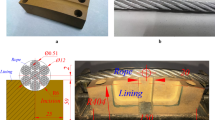Abstract
The problem of leaf residue and loss of adhesion in the wheel/rail track contact has been studied in ball-on-disc test device. The friction properties of sycamore leaf samples were measured for a range of speeds and imposed slip at a maximum contact pressure of 1.0 GPa. At the end of the test the leaf lubricant films were examined under a low-power microscope and the organic content analysed by Infra-Red (IR) Reflection-Absorption Microspectroscopy. The test samples included water-saturated leaves and the supernatant soaking water to measure the effect of water-soluble leaf components. The results were compared to pure water. During the initial film formation the leaf samples rapidly formed a slurry composed of small black particles, this dried to a thick adherent black film as the test proceeded. This suggested that the black film was due to a chemical reaction between the water-soluble leaf component and steel rather than as the result of charring of the organic material. Friction coefficients of the leaf slurry were in the range μ = 0.03–0.06 (50% slip) compared to values of μ = 0.15–0.2 for pure water. Friction was also reduced in tests with the leaf-soaking water, suggesting that water-soluble leaf components (identified as pectin) play a role in the low adhesion mechanism. IR analysis showed that the black residue films contained pectin (pectate) and cellulose derived from the leaf samples. Pectin appears to play an important role in the lubrication process. In the presence of metal ions pectin will gel and thus could form a thin but highly viscous layer on the track surface. This gel will also flocculate cellulose to create the black biomass, which provides the lubricating film.










Similar content being viewed by others
References
U. Olofsson and K. Sundvall, Proc. Instn. Mech. Engrs. Part F, 218 (2004) 235
C.R. Fulford, ed. “Review of low adhesion research”. Report published by the Railways Safety and Standard Board, (2004)
T.M. Beagley, C. Pritchard, (1975) Wear 35:299
U. Olofsson, T. Telliskivi, (2003) Wear 254: 80
T.M. Beagley, C. Pritchard, D.A. Smith (1974) Wear 29: 309
T.M. Beagley, L.J. McEwen, C. Pritchard, (1975) Wear 33: 77
H. Chen, T. Ban, M. Ishida, T. Nakahara (2002) Wear 253: 75
R.D. Sims, K.A. Miller and G.F. Schelpmann Jr., Proc. ASME/IEEE Joint Railroad Conf. (1996) 23
D.J. Cosgrove, (1997) Ann. Rev. Cell Dev. Biol. 13: 171
L. Taylor, Ph.D. Thesis, London University, (2001)
G.J. Johnston, R. Wayte, H.A. Spikes (1991) Tribol. Trans. 34: 187
R.H. Wilson, A.C. Smith, M. Kačuráková, P.K Saunders, N. Wellner, K. Waldron, (2000) Plant Phys. 124: 397
M. Mascarenhas, J. Dighton, G.A. Arbuckle (2000) Appl. Spec. 54: 681
N. Wellner, M. Kačuráková, M. Malovíková, R.H. Wilson, P.S. Belton, (1998) Carbohydr. Res.308: 123
J. Singthong, S. Ningsanond, S.W. Cui, H. Douglas Goff, (2005) Food Hydrocolloid 19: 793
A. Synytsya, J. Čopîková, P. Matĕjka, V. Machovič, (2003) Carbohydr. Polymers 54: 97
M. Kačuráková, P. Capek, V. Sasinkova, N. Wellner, V. Nad Ebringerova, (2000) Carbohydr. Polymers 43: 195
P.M. Cann, (1997) NLGI Spokesman 61:22
J.S. Amthor, (2003) Ann. Bot. 91: 673
H. Yokoi, T. Obita, J. Hirose, S. Hayashi, Y. Takasaki, (2002) Bioresour. Technol. 84: 287
Acknowledgments
The author would like to thank Graham Plant and the Wadhurst Commuters for stimulating discussion concerning the leaves problem and suggestions for the project.
Author information
Authors and Affiliations
Corresponding author
Rights and permissions
About this article
Cite this article
Cann, P. The “leaves on the line” problem—a study of leaf residue film formation and lubricity under laboratory test conditions. Tribol Lett 24, 151–158 (2006). https://doi.org/10.1007/s11249-006-9152-2
Published:
Issue Date:
DOI: https://doi.org/10.1007/s11249-006-9152-2




